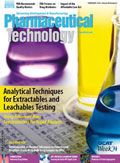News
Article
Pharmaceutical Technology
Advances in UPLC Techniques and Column Chemistry Aid the Confirmation of Biosimilarity
Author(s):
Automated sample handling, advanced glycan analysis, and specially designed columns are help speed up confirmation of the biosimilarity.

Although proteins are known to be linear chains of amino acids that can form three-dimensional (3D) structures and enable binding interactions with specific biologic molecules, only recently have biopharmaceutical companies begun to pay more attention to their higher-order structure (HOS) of proteins. The previous lack of attention to this area is surprising given the crucial role this specific attribute plays with respect to the stability, efficacy, and safety (e.g., immunogenicity) of protein-based drugs. While there are numerous effective analytical methods for determining the chemical composition of proteins, such as the order of amino acids in linear chains, the weakest link in the development of protein therapeutics, according to Steven Berkowitz, a senior principle scientist at Biogen Idec, is HOS characterization. Much of this problem is a result of the limited capability of biophysical methods to obtain this information for routine purposes.
While there are several types of analyses that can give low-resolution structural information (e.g., fluorescence, ultraviolet-visible [UV-VIS] analysis, circular dichroism [CD], etc.) and even more detailed data (e.g., differential scanning calorimetry [DSC], vibrational circular dichroism [VCD], and analytical ultracentrifugation [AUC]), only two methods to date—hydrogen deuterium exchange-mass spectrometry (HDX-MS) and nuclear magnetic resonance (NMR) spectroscopy—are capable of providing detailed high-resolution fingerprint data on the HOS of proteins. Of the two, HDX-MS (which provides this high-resolution fingerprint indirectly) is becoming increasingly adopted as advances in instrumentation, methods, and software for data analysis are making this technique more accessible. NMR, while capable of determining the 3D structure of a protein directly, is slowly finding more frequent use due to the need to overcome several hurdles.
A breakdown on higher-order protein structure
Proteins have multiple layers of structure. The primary structure consists of the linear order of amino acids. When this linear structure folds on itself, it can take the form of an α-helix, β-sheet, or other shape, which comprises the secondary structure. The secondary structure can also fold to different degrees, and this level of folding is considered to be the tertiary structure of the protein. Although this folding can to some extent be stabilized via the formation of permanent interactions, (e.g., covalent disulfide bonds) folded protein structures are predominantly stabilized through weak interactions, such as hydrogen bonding and van de Waals interactions, which can be easily disrupted with changes in temperature, pH, protein concentration, and other conditions. HOS includes everything but primary structure, with some emphasis on tertiary structure.
Sample manipulation
Higher-order protein structure is crucial for the performance of protein-based drugs. Because some aspects of the HOS of proteins can change in response to changes in the protein environment, it is important that the behavior of the protein structure under different conditions and the actual structure of the protein in the formulated product be as well-defined as possible. This sensitivity of the HOS of proteins to the environment can cause problems with some biophysical characterization techniques. These technologies require the use of a different solvent, high dilution, high-salt concentrations, and/or the removal of interfering excipients, or require other conditions that are different from the environment of the formulated product, says Berkowitz. As a result, the structure being analyzed may not be the structure of the protein in the drug product. Therefore, biophysical characterization techniques that do not significantly alter the sample environment are highly valued. The results from analytical methods that do require changes to the formulation matrix of a therapeutic protein must be carefully designed so that meaningful comparisons can be made and the actual presence of real differences detected.
Low-resolution HOS analysis
Although common and simple routine biophysical characterization techniques such as calorimetry, absorbance, and fluorescence provide low-resolution information on protein structure, collectively this information provides a coarse fingerprint picture of the HOS of protein drugs.
Because different types of protein structural elements are known to melt at different temperatures, observing the melting behavior of a protein using DSC can provide some basic information about these structural elements in the protein, which generally correspond to higher-order structural elements, such as domains or possibly super-secondary structures, explains Berkowitz. Analysis of the UV–VIS absorption and fluorescence spectra of a protein provides general information about the local environments of the aromatic amino acids. Information about the amides in the peptide bond present along the polypeptide backbone of the protein can be obtained using fourier transform infrared spectroscopy.
“The overriding problem here, unfortunately, is the limited resolution. For example, the signals from all of the aromatic acids in the UV–VIS or fluorescence spectra just overlap too much to see the individual peaks. In fact, it is this low-resolution that initially lulled researchers into not paying attention to the HOS of these drugs,” Berkowitz observes.
Determination of secondary structure with VCD
Another technique based on the vibrational motion of atoms in the protein is VCD spectroscopy, which is useful for determining the secondary structure of proteins, notes Wasfi Al-Azzam, a scientist in the Bioanalytical Sciences department at GlaxoSmithKline. VCD is sensitive to the interactions of dipoles, and the information in VCD spectra (e.g., peak frequencies, signs, patterns, and band shapes) makes it possible to distinguish between different secondary structures.
“This technique has the advantages of being effective at high concentrations and in various liquids, including water and buffer solutions,” Al-Azzam notes. “It is, in fact, specific for high concentrations and is being increasingly used as a result, because growing numbers of protein therapeutics are being formulated at high concentration for subcutaneous delivery. The minimal level of sample manipulation is a real benefit,” he continues.
VCD is also being used more frequently for comparability studies (e.g., under varying temperature and pH conditions). The spectrum obtained provides a fingerprint of the secondary structure of the protein, and can indicate the formation of fibrils and other folded forms. Conformational changes can also be seen to some extent, according to Al-Azzam.
The only real limitation for this method is the concentration, which has a lower limit of < 100 mg/mL, although taking longer scans can extend that level somewhat. As protein-based drugs have increased in size, the fact that there is no limit on the size of the proteins that can be analyzed has become important. Even insoluble proteins and aggregates can be evaluated. Al-Azzam also points out that advances in instrumentation have contributed to the increased use of this analytical method, including improvements in the laser and photomultiplier, as well as the detectors, which have led to improvements in the quality of the spectra and the sensitivity.
Growing use of AUC
The use of AUC by the biopharmaceutical industry has been growing since the 1980s and early 1990s when its use as a complement to size-exclusion chromatography (SEC) was shown to be invaluable for the detection of aggregates that often are not observed using the former method, comments Tom Laue, a professor at the University of New Hampshire and cofounder of Spin Analytical, a developer of recently commercialized next-generation AUC instrumentation
AUC can provide two types of data—the sedimentation velocity (most common) and the sedimentation equilibrium. In both experiments, the material is placed in the centrifuge and its movement from the top to the bottom of the centrifuge tube is monitored with various optics systems/detectors, including UV–VIS and fluorescence detectors and refractometers. A chromatogram-like graph is produced with a baseline and peaks. The x-axis, rather than time, is the sedimentation coefficient, which is directly related to the ratio of the material’s molar mass and its size, and thus its state of aggregation. Sedimentation coefficients for monomeric monoclonal antibodies (mAbs) typically range from 6.1-6.9, while the value is around 9 for mAb dimers and 12 for mAb trimers. Thus, the data can be used to quantify the amount of dimer and trimer present, although it is not accurate at very low levels (<1%).
With sedimentation equilibrium, the data are directly proportional to the material’s molar mass. For either velocity or equilibrium sedimentation, samples with different protein concentrations are analyzed to determine if the fractional amount of aggregate increases or remains constant with protein concentration. A lack of change in the amount of aggregate formation indicates the presence of irreversible bonding, while an increase in aggregate formation with concentration proves the presence of reversible interactions.
The advantage of AUC over SEC is that aggregates can be unknowingly retained on the column, and even if present at just 1–2%, these protein structures can be a real problem in the formulated drug, Laue points out. In addition, the high salt concentrations used with SEC have the potential to influence the protein HOS, as does the significant dilution of the sample that passes through the column. “AUC can be carried out in any liquid and does not suffer from these issues. As a result, it has become an excellent orthogonal method for confirmation of SEC results,” Laue states.
There is also growing interest in using AUC to evaluate the behavior of protein therapeutics in different media, such as serum. “In some cases, proteins are designed to interact with components like albumen to influence the pharmokinetics, while in other cases interactions are not desired. AUC can be used to determine if these types of interactions are occurring,” Laue explains.
The biggest limitations are the complexity of the data workup and the length of time for each analysis. Laue, however, notes that there are numerous workshops offered on a regular basis that provide training on data analysis, and he also expects that the software will continue to improve. “Throughput is the biggest issue. Only 7-8 samples can be done per day,” he says. John R. Engen, professor of bioanalytical chemistry at Northeastern University, notes that multi-angle light scattering is also being increasingly used along with SEC to obtain information similar to that available from AUC, but more rapidly.
High-resolution structure determination
Unfortunately, methods that provide high-resolution structural information suffer from lengthy analysis times and require training in data interpretation. According to Berkowitz, this situation, however, is changing for proteins that crystallize, x-ray crystallography can provide the most information, and depending on the protein, the analysis can be achieved rapidly. For proteins that do not crystallize, advances are being made particularly for HDX-MS, and to some extent, NMR.
“NMR can provide massive amounts of information,” says Berkowitz. For some large and complex proteins, however, too much overlapping information is obtained such that it is difficult to deconvolute the spectral data. “Advances in analytical tools that make NMR more amenable for larger molecules and more complex structures are needed,” he adds. “Despite the high cost of NMR instruments, the high level of training required, and the complex data analysis, NMR plays a useful role in characterizing the HOS of protein biopharmaceuticals in certain cases. In the future, however, NMR should eventually be a dominant and valuable tool in the biopharmaceutical industry for the characterization of the HOS of proteins. We just need more innovation.”
HDX–MS has seen wider adoption than NMR due to significant advances in both the instrumentation and software tools, observed Engen. “The introduction by Waters Corporation of an instrument available for HDX-MS that includes the instrumentation, additional specialized equipment, and software tools for data analysis has greatly increased HDX-MS use in the marketplace. Better processing power and software for data analysis have also made the experiment more accessible to people,” he notes.
In addition, as the number of biotherapeutic proteins has increased, so has the use of HDX-MS because it provides useful information that is hard to obtain using other methods in a relatively short period of time for a wide variety of proteins, says Engen. “For example, proteins, and even specific conformational states of proteins that won’t crystallize can be studied under conditions that mimic physiological conditions. Furthermore, the location of effects in proteins that are hard to see with other techniques, such as the allosteric effects of binding, can be obtained because HDX-MS has higher spatial resolution than most classical biophysical tools (except NMR and x-ray crystallography),” he explains.
There are some limitations, though. In HDX-MS, backbone amide hydrogens are detected through exchange of hydrogen and deuterium, and some sites involved in complex formation are in side-chain hydrogen’s, which are generally not detected by MS. Not all interactions (such as binding) alter the environment of backbone amide hydrogens, particularly in folded proteins, and a good understanding of the theory is essential to make sense of the data. In addition, analysis of large proteins (>500 kDa) is challenging because large numbers of peptides are produced during the analysis, and the data processing can be difficult or the spectrum can be compromised due to suppression of some signals as a result of complex mixes of peptides.
Obtaining single-amino acid resolution is also a challenge. “Methods like electron-capture dissociation and electron-transfer dissociation fragmentation inside the mass spectrometer try to address this issue but they are not without problems. Most importantly, there is yet very little software available to evaluate the data obtained from these analyses,” Engen says. He also notes that creating many overlapping peptides, a technique that has been known for many years, can be used to increase resolution. By altering the digestion conditions, the mix of peptides produced can be slightly altered, and then subtractive analysis can be used to extract the data. This method, however, has some downsides and does not totally solve the problem.
Despite these issues, both Engen and Berkowitz see a bright future for HDX–MS. “This method is already leaps and bounds ahead of where it was 10 years ago, and great strides have been made in just the last 5 years as well. We used to be afraid of proteins larger than 30 kDa, and now we are routinely working with analytes that are 200 kDa, and HDX-MS is now a common analytical technique,” Engen asserts.
In fact, HDX-MS data are starting to be used more extensively in the biopharmaceutical industry. “HDX–MS data appear in filings with FDA and are used to check formulation and comparability, to look at small molecule binding, and to map epitopes,” Engen observes. He goes on to add that academic research groups continue to further advance the limits of the method by expanding into the membrane protein space, enabling the analysis of ever larger complexes and improving the analytical aspects at every step.

Newsletter
Get the essential updates shaping the future of pharma manufacturing and compliance—subscribe today to Pharmaceutical Technology and never miss a breakthrough.





